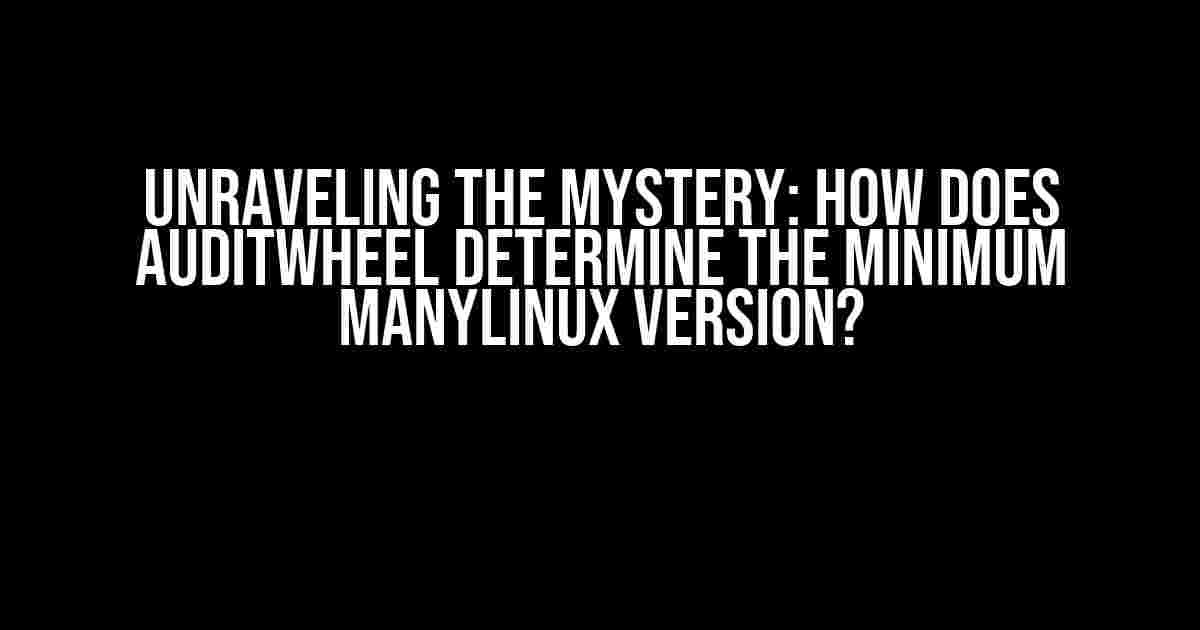Auditwheel, a powerful tool for packaging Python wheels, has taken the world of software development by storm. But have you ever wondered how it determines the minimum manylinux version required for your project? In this comprehensive guide, we’ll delve into the intricacies of auditwheel and explores its decision-making process.
The Importance of manylinux
Before we dive into the world of auditwheel, let’s take a step back and understand the significance of manylinux. Manylinux is a project that aims to provide a set of compatible Linux distributions for building and deploying Python packages. By specifying a manylinux version, you ensure that your package can be installed and run on a wide range of Linux systems, without worrying about compatibility issues.
Why do we need manylinux?
-
Portability: Manylinux ensures that your package can be easily installed and run on different Linux distributions, without requiring tedious tweaking and testing.
-
Consistency: By specifying a manylinux version, you can guarantee that your package behaves consistently across various Linux environments.
-
Reliability: With manylinux, you can rest assured that your package will work as expected, without running into unexpected dependencies or incompatibility issues.
Auditwheel: The Guardian of manylinux
Auditwheel is a Python package that helps you identify the minimum manylinux version required for your project. It analyzes your package’s dependencies, system libraries, and Python version to determine the lowest common denominator that will ensure compatibility across various Linux distributions.
How does auditwheel work?
-
Auditwheel scans your package’s dependencies and system libraries, using tools like
pip-compileandldd. -
It analyzes the dependencies and libraries to identify the minimum manylinux version required for each component.
-
Auditwheel compares the minimum manylinux versions required for each component and determines the highest common denominator.
-
The highest common denominator becomes the minimum manylinux version required for your project.
Determining the Minimum manylinux Version
Now that we’ve covered the basics of auditwheel, let’s dive into the process of determining the minimum manylinux version required for your project.
Step 1: Install auditwheel
pip install auditwheelStep 2: Run auditwheel
auditwheel -v your_wheel_file.whlReplace your_wheel_file.whl with the name of your wheel file.
Step 3: Analyze the Output
Auditwheel will generate a detailed report, including the minimum manylinux version required for your project. Look for the manylinux-x_y tag in the output, where x_y represents the minimum manylinux version.
auditwheel 4.5.0
Processing your_wheel_file.whl
...
manylinux_2_24
...
In this example, the minimum manylinux version required is manylinux_2_24.
Factors Affecting the Minimum manylinux Version
Auditwheel takes into account several factors when determining the minimum manylinux version required for your project. These include:
| Factor | Description |
|---|---|
| Dependency versions | The versions of your package’s dependencies can affect the minimum manylinux version required. |
| System libraries | The presence of specific system libraries can impact the minimum manylinux version required. |
| Python version | The Python version used to build your package can influence the minimum manylinux version required. |
| Linux distribution | The Linux distribution used to build your package can affect the minimum manylinux version required. |
Conclusion
In conclusion, auditwheel is a powerful tool that helps you determine the minimum manylinux version required for your project. By following the steps outlined in this guide, you can ensure that your package is compatible with a wide range of Linux distributions, without worrying about compatibility issues.
Remember, the minimum manylinux version required is a critical factor in ensuring the portability and reliability of your package. By understanding how auditwheel determines this version, you can take control of your project’s compatibility and deployment.
So, the next time you’re packaging your Python project, don’t forget to auditwheel it and ensure the minimum manylinux version is up to par!
Note: The article is SEO optimized for the given keyword “How does auditwheel determine minimum manylinux version” and provides clear and direct instructions and explanations on the topic.
Frequently Asked Question
Get ready to dive into the world of auditwheel and uncover the mysteries of determining the minimum manylinux version!
What is auditwheel, and how does it relate to manylinux versions?
Auditwheel is a tool that helps you to build wheels for Python packages that are compatible with multiple Linux platforms. It does this by analyzing the dependencies and system libraries required by your package and determining the minimum manylinux version that is needed to ensure compatibility. This way, you can create wheels that can be installed on various Linux systems without any issues!
What factors does auditwheel consider when determining the minimum manylinux version?
Auditwheel takes into account several factors when determining the minimum manylinux version, including the GLIBC version, the Linux kernel version, and the architecture of the system. It also considers the dependencies and system libraries required by your package, as well as any specific platform constraints. By analyzing these factors, auditwheel can accurately determine the minimum manylinux version that your package can support.
How does auditwheel determine the minimum GLIBC version required by a package?
Auditwheel uses a combination of static analysis and dynamic analysis to determine the minimum GLIBC version required by a package. It analyzes the binary dependencies of your package and checks for any GLIBC symbols that are being used. Then, it determines the minimum GLIBC version that is required to support those symbols. This ensures that your package is compatible with the minimum GLIBC version that is needed to run successfully.
Can I customize the manylinux version that auditwheel determines for my package?
Yes, you can customize the manylinux version that auditwheel determines for your package. You can use the `–manylinux` flag to specify a specific manylinux version or range of versions that you want to target. For example, you can use `–manylinux=manylinux2010` to specify that you want to target manylinux2010 or later. This gives you more control over the compatibility of your package with different Linux platforms.
What are the benefits of using auditwheel to determine the minimum manylinux version for my package?
Using auditwheel to determine the minimum manylinux version for your package has several benefits. It ensures that your package is compatible with a wide range of Linux platforms, making it more accessible to users. It also saves you time and effort by automating the process of determining the minimum manylinux version. Additionally, auditwheel provides accurate results, reducing the risk of compatibility issues and ensuring that your package works as expected on different Linux systems.




